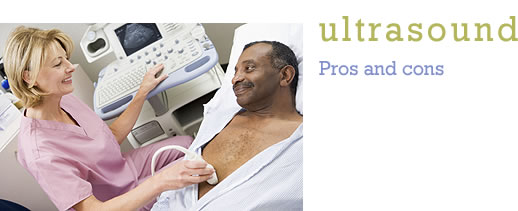Health Tips - Ultrasound

Ultrasound is a procedure for getting images of internal organs, fetuses and soft tissues such as muscles and tendons. It is not usually used to get information regarding bones.
High frequency sound waves that are beyond human hearing are used in an ultrasound. ("Ultra" is a Latin word meaning “beyond”.) A probe is passed over an area of interest to send the sound waves into the area, for usually 10 - 15 minutes. The waves partially bounce or “echo” back from the body tissues and organs. They are then transformed and displayed on a computer screen as an image.
Ultrasound procedures can cost from $100.00 to over $1000.00. For that, you can get a wealth of information that is crucial to your health, concerning heart disease, stroke, abnormalities in the abdomen or reproductive system, etc.
Safety of Ultrasound
As no radiation is involved, this is a safer imaging procedure than CT scans (more on these soon). However, ultrasound produces heat, pressure changes and mechanical disturbances in tissue. These can be hazardous to sensitive organs and a fetus. There are several studies that have shown harmful effects of ultrasound on pregnant mammals such as mice.
Unfortunately, obstetricians often use ultrasound on pregnant women on most office visits. (Obstetricians used to commonly X-ray women to view the fetus.) It is best to avoid the use of routine ultrasound for low-risk pregnancies. Even the FDA discourages its use for non-medical purposes such as fetal keepsake videos and photos.
My Recommendations:
- Take 6 Core Level Health Reserve before this test is done.
- If you are pregnant, tell your doctor that you want to keep the length of the ultrasounds as short as possible to get only the information they must have.
- Unless you have a high-risk pregnancy, try to keep the number of ultrasounds down to 2 total for the entire pregnancy. During the first trimester, the doctors like to see if everything is normal. Close to your delivery, they like to see the position of the baby.
- Do not allow the use of ultrasound as part of physical therapy. There are too many successful, noninvasive techniques available. For example, see my successes with back problems and knee and leg problems.
- Come in to my office for a treatment after having an ultrasound, especially if you are pregnant.
Ultrasound is a wonderful, useful tool, but keep it to a minimum!
Dr. Pepi
August 12, 2010
